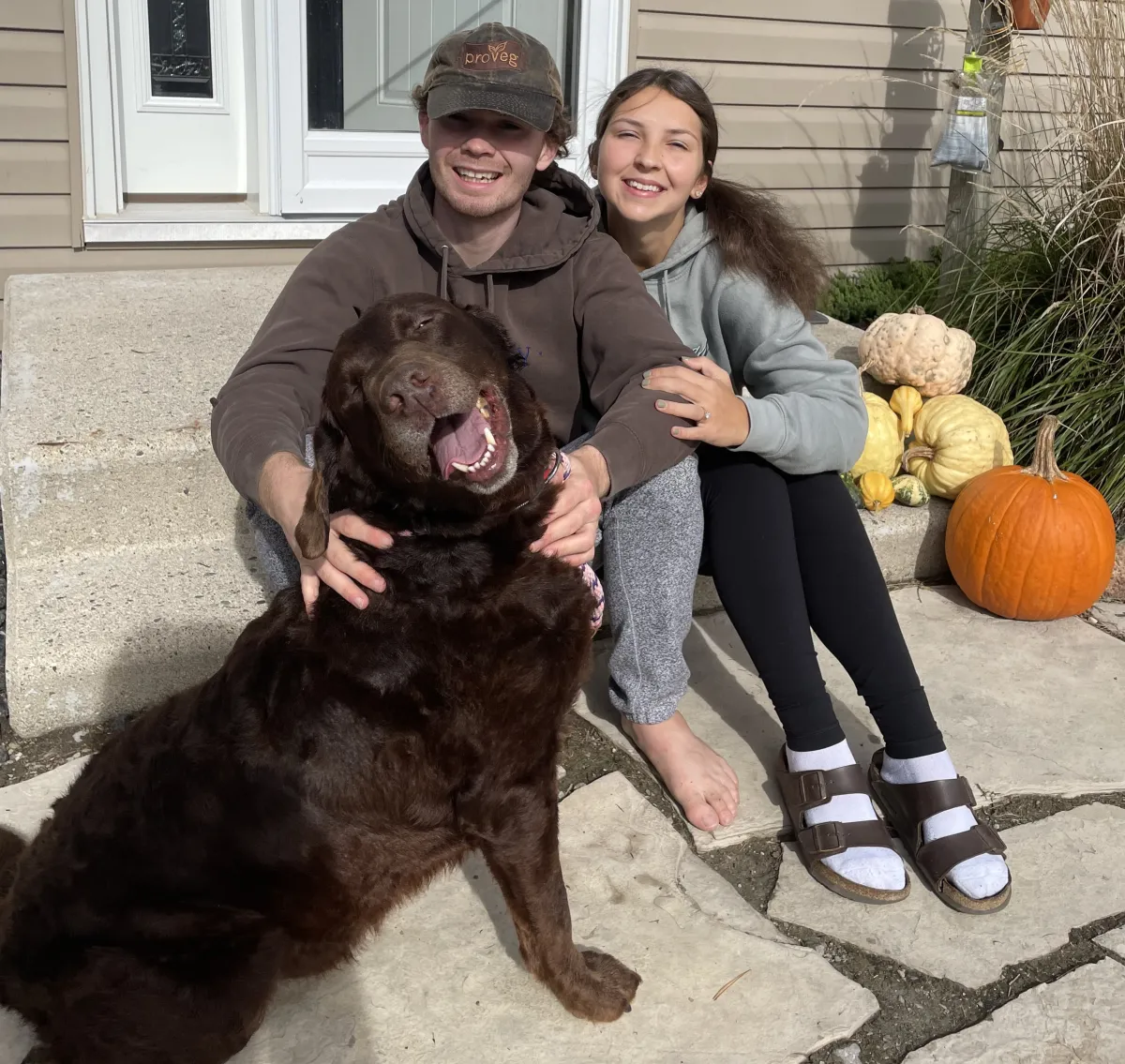Are you struggling to train your Sheepadoodle puppy effectively? Mastering puppy training can transform your furry friend into a well-behaved companion you’ll adore.
As a Sheepadoodle enthusiast, I understand that raising a smart, energetic pup comes with unique joys and challenges. I’ll share training tips grounded in real-world experience, tailored to this lovable breed.
Sheepadoodle puppy training is the foundation for a happy, obedient dog. The right techniques can harness their intelligence and energy while addressing quirks like herding instincts.
In this guide, you’ll discover breed-specific training techniques, tools, and schedules to set your Sheepadoodle up for success.
Let’s get started!
Understanding Your Sheepadoodle Puppy’s Unique Traits
Sheepadoodle puppies are a smart mix of Poodle and Old English Sheepdog, which gives them some special traits to keep in mind. Their Poodle side brings high intelligence and a strong willingness to learn, making training quicker but also needing plenty of mental challenges. From the Old English Sheepdog part, they inherit herding instincts and lots of energy, so they’re naturally active and can sometimes try to herd people or other pets.
These traits mean your Sheepadoodle puppy needs consistent mental stimulation and early socialization to thrive. Without this, their intelligence and energy can lead to boredom, which often shows up as nipping, barking, or even separation anxiety. Many Sheepadoodles nip to herd or explore, bark when they’re excited or anxious, and can struggle when left alone for too long.
Understanding these behaviors helps you set expectations and plan training that fits their unique needs. Focusing on gentle, positive reinforcement training combined with plenty of social experiences will keep your Sheepadoodle happy and well-adjusted.
Setting Up for Training Success

Creating a Training Environment
To get your Sheepadoodle puppy off on the right foot, start by puppy-proofing your home. Remove anything they could chew that might be dangerous like wires, small objects, or toxic plants. Next, set up a crate in a quiet, comfortable spot. This crate will be their safe space and a key tool for training.
Make sure you have all the essential supplies ready:
- Crate with cozy bedding
- Treats for rewards
- A sturdy leash for walks and control
- Durable chew toys to redirect biting and nipping
Establishing a Training Schedule
Consistency is everything when training Sheepadoodle puppies. From 8 weeks to about 6 months, stick to a daily routine:
- Frequent potty breaks, especially after meals and naps
- Short training sessions, several times a day to keep their attention
- Regular playtime and socialization opportunities
This steady schedule helps your puppy learn what to expect and builds good habits early on.
Choosing Positive Reinforcement
Sheepadoodles respond best to positive reinforcement—think treats, praise, and lots of affection. Rewards motivate them to repeat good behaviors. Avoid punishment or harsh corrections, as these can break trust and slow down training. Instead, encourage the behaviors you want to see by making training fun and rewarding. This approach builds a strong bond and makes learning easier for your Sheepadoodle.
Core Training Techniques for Sheepadoodle Puppies
Potty Training
Potty training your Sheepadoodle puppy requires consistency and patience. Follow these simple steps:
- Frequent breaks: Take your puppy outside often, especially after eating, drinking, playing, or waking up.
- Crate training: Use the crate to help your pup hold it in; dogs naturally avoid soiling their sleeping area.
- Reward system: Praise and treats immediately after they go potty outside reinforce good behavior.
Most Sheepadoodles catch on by around 13 weeks if you keep a steady routine and stay patient.
Crate Training
Crate training helps with anxiety and makes potty training easier. To create a safe space:
- Introduce the crate gradually with the door open at first.
- Add cozy bedding to make it inviting and comfortable.
- Use treats and toys to encourage your puppy to spend time inside.
This approach helps your Sheepadoodle see the crate as their personal den, making alone time less stressful.
Basic Commands
Teaching basic commands like sit, stay, come, and leave it is straightforward with Sheepadoodles. Their intelligence and eagerness to learn make training smoother. Use short, positive sessions with lots of praise and treats. This helps them grasp commands quickly and builds a strong foundation for good behavior.
Socialization
Socialization is key between 8 and 16 weeks. Introduce your puppy to:
- Different people
- Other dogs
- Varied environments
Positive exposure during this time prevents alert barking and wariness of strangers. Make these experiences fun and relaxed so your Sheepadoodle grows confident, well-adjusted, and friendly.
Addressing Common Sheepadoodle Behavioral Challenges
Managing Nipping and Herding Instincts
Sheepadoodle puppies often show nipping and herding behaviors thanks to their Old English Sheepdog roots. To handle these:
- Redirect nipping to appropriate items like chew toys or bully sticks to satisfy their need to bite safely.
- Discourage herding by teaching your puppy to stop chasing or circling children and other pets. Use gentle commands and positive reinforcement to replace herding with calmer behaviors.
Reducing Barking
Barking can become an issue if not addressed early. To manage this:
- Identify triggers, such as strangers, boredom, or noises, that cause your Sheepadoodle to bark.
- Use desensitization techniques by gradually exposing them to these triggers at a low intensity while rewarding calm behavior.
- Teach a quiet command that signals your dog to stop barking on cue.
Handling Separation Anxiety
Sheepadoodles can get anxious when left alone, so it’s important to:
- Start with gradual alone-time training, beginning with just 30 seconds and slowly increasing the duration.
- Use tools like puzzle toys and calming treats to keep your puppy occupied and relaxed when you’re not around.
For a deeper dive into managing separation anxiety and crate training, check out our guide on crate training a Sheepadoodle.
Advanced Training and Mental Stimulation
Sheepadoodle puppies are smart and full of energy, so keeping their minds active is just as important as physical exercise. Teaching fun tricks like spin, roll over, or shake is a great way to engage their brains and strengthen your bond. These tricks tap into their intelligence and make training sessions enjoyable.
For the more active Sheepadoodles, introducing basic agility or nosework can be a game-changer. Agility courses with simple jumps and tunnels provide a physical and mental challenge that helps burn off energy. Nosework games encourage natural sniffing instincts while boosting focus.
Puzzle toys and interactive games are excellent tools for mental stimulation. Look for treat-dispensing toys or puzzles that require problem-solving—these keep your puppy busy and reduce unwanted behaviors caused by boredom. You can also create easy DIY games at home like hiding treats under cups or inside folded towels to keep your Sheepadoodle engaged and learning.
By incorporating tricks, agility, and puzzle games into your routine, you’ll help your Sheepadoodle puppy develop into a well-rounded, happy dog.
Local Resources and Community Support
Finding Sheepadoodle-friendly trainers or classes in your area can make a big difference in your puppy’s training success. Look for trainers experienced with Sheepadoodles or similar breeds—they understand the mix of intelligence and energy well. Many cities have dog training centers offering group classes or private sessions that fit your schedule.
Joining local Sheepadoodle meetups or online communities, like the Sheepadoodle platform, connects you to other owners who share advice, tips, and support. These groups are great for socializing your puppy, swapping training techniques, and staying motivated.
Benefits of connecting with other Sheepadoodle owners include:
- Access to breed-specific training tips and advice
- Sharing success stories and challenges
- Opportunities for puppy playdates and socialization
- Recommendations for local vets, groomers, and trainers
Tap into these resources to build a strong support network that helps your Sheepadoodle grow into a well-behaved, happy dog.
Long-Term Training Tips for a Well-Behaved Adult Sheepadoodle
Keeping your Sheepadoodle well-behaved as they grow means staying consistent with training. Even after the puppy stage, which typically lasts up to 1.5 years, it’s important to keep reinforcing commands and good manners. Here’s what to focus on:
- Stick to routines: Keep daily training sessions short but regular to refresh skills like sit, stay, come, and leash walking.
- Adapt training to age: Between 6 to 18 months, your Sheepadoodle enters adolescence. Expect some stubbornness or bursts of energy. Stay patient and firm without harsh corrections.
- Manage energy levels: Offer plenty of physical exercise and mental games to reduce hyperactivity. This channels their high energy productively.
- Address new challenges: You might see testing behaviors as your pup gains confidence. Redirect unwanted behavior with consistent commands and reward good choices.
- Stay social: Continue socializing your adult Sheepadoodle with people and other dogs to prevent fear or aggression.
Remember, steady guidance and patience help turn your Sheepadoodle into a dependable, happy adult companion.

